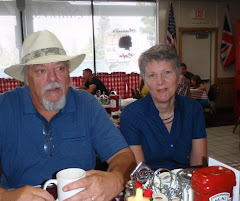However at about mile 36 we enter into the Stikine River Recreation Area and we find that there is a pull out available. We stopped and take a short walk up to an overlook that gave us a real panoramic view of the entire valley. Pretty Nice.


Another couple of miles down the road we came to a spot where we had a pretty good view of Mount Edziza. We couldn’t resist and took more pictures of the extinct volcano.

It wasn’t very long down the road and we saw this sign.

The sign didn’t lie. It was about to get exciting. Actually the road was in good condition for a gravel road, no pot holes. However it was very curvy and when traversing the mountains the switch backs could be pretty narrow and you were looking a long way down. In retrospect I handled it a lot better than I thought I would.



We found ourselves pulling over quite a few times so that we could get pictures and I could enjoy the scenery. The drive was not one where you let you attention waiver.



At the 56 mile point the road ran through lava beds on a narrow promontory that was about 150 feet wide. The drop on each side was about 400 feet into the Stikine and Tahltan Rivers. The Tahltan runs into the Stikine less than a mile from this point. We found a place to park the truck and took a walk to get pictures. This is where the Grand Canyon of the Stikine starts. We learned afterwards that the promontory we were driving and standing on is undercut. Not sure if that is the correct wording but it was like standing on an hour glass. The ground cut in under the part we were on but you could see that only from the air. I wish I had taken a picture of Kathy’s face when we learned that.
















After we left the Promontory we followed the Stikine River all the way into Telegraph Creek. As we were still on our up and down route the scenery all the way in was pretty spectacular.



We arrived in Telegraph Creek and learned that it is mostly a native village as about 350 members of the Tahltans First Nation reside here. There is also about 50 white settlers many who have been here from the early 60’s & 70’s. The town originated when gold was discovered in the Yukon and the Stikine River became another way into the gold fields. This was as far as the paddle wheelers could get so Telegraph Creek and Glenora were born. There is a huge section of the old town that is run down and mostly deserted which is right down by the river. The new section of town has been built on higher ground.



After we left Telegraph Creek we headed to Glenora. Mainly just to see what was there. Not much. Glenora got it’s start at the same time as Telegraph Creek as there are only 12 miles apart. At one time, around 1898, there was a large tent city in Glenora that held over 10,000 people. One interesting aspect of Glenora is that reportly this is where a lot of the Vietnam Draft Dodgers fled too. In spite of the fact that they were granted amnesty by the Carter Administration ( I think ) many chose to stay and some of them still live there.


We left Glenora and headed back to Dease Lake where we planned to spend the night. During our drive we noticed that the road had recently been watered down which really helped with the dust. However when you add water to dry roads you get mud. It took me 35 minutes to pressure wash the camper and truck before we could set up. In spite of this we had a glorious day.
In reviewing our day we both agreed that it was pretty spectacular but if you had to pick one between today and Salmon Glacier, we would both go with the drive to Salmon Glacier. After all it was specnomenal.
In reviewing our day we both agreed that it was pretty spectacular but if you had to pick one between today and Salmon Glacier, we would both go with the drive to Salmon Glacier. After all it was specnomenal.




.jpg)

No comments:
Post a Comment